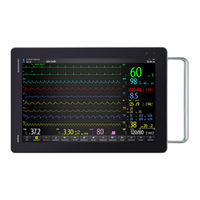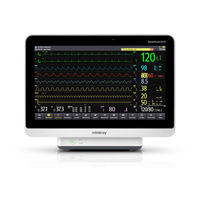Mindray BeneVision N12 Patient Monitor Manuals
Manuals and User Guides for Mindray BeneVision N12 Patient Monitor. We have 3 Mindray BeneVision N12 Patient Monitor manuals available for free PDF download: Operator's Manual, Service Manual, Quick Reference Manual
Mindray BeneVision N12 Operator's Manual (528 pages)
Patient Monitor
Brand: Mindray
|
Category: Medical Equipment
|
Size: 6 MB
Table of Contents
-
Safety33
-
Warnings33
-
Cautions34
-
Notes34
-
Intended Use37
-
Menus59
-
Quick Keys59
-
Privacy Mode62
-
Night Mode62
-
Standby Mode63
-
User Screens75
-
Remote View92
-
Alarm Watch94
-
Mldap95
-
Troubleshooting102
-
Alarms111
-
Alarm Categories111
-
Alarm Priorities112
-
Alarm Indicators112
-
Resetting Alarms120
-
Latching Alarms120
-
Nurse Call121
-
Calling for Help121
-
CPB Mode121
-
Intubation Mode122
-
Testing Alarms122
-
ECG Introduction123
-
ECG Display124
-
ECG Relearning148
-
Calibrating ECG149
-
Resp Display156
-
Spo Introduction161
-
Spo Display164
-
NIBP Display179
-
NIBP Maintenance183
-
IBP Introduction185
-
Measuring ICP187
-
IBP Display188
-
Measuring PAWP192
-
Measuring PAWP193
-
C.O. Display198
-
Troubleshooting202
-
Scvo Display203
-
Guide204
-
Measuring Scvo204
-
Scvo Calibration205
-
Setting Hb/Hct205
-
Value206
-
CCO Display208
-
Cco/Svo2 Cable208
-
ICG Introduction217
-
ICG Display218
-
CCO Introduction223
-
Picco Display224
-
CCO Display224
-
Part Display225
-
Pcvp Display225
-
CO Introduction231
-
CO Display232
-
CO Calibration240
-
AG Introduction243
-
AG Display244
-
MAC Values246
-
RM Introduction251
-
RM Parameters251
-
RM Display252
-
Viewing V-CO260
-
Curve260
-
Tcgas Parameters264
-
EEG Introduction265
-
EEG Parameters266
-
EEG Display266
-
CSA View273
-
DSA View274
-
BIS Introduction277
-
BIS Parameters279
-
BIS Display280
-
Sensor Check283
-
NMT Introduction287
-
NMT Parameters289
-
NMT Display289
-
NMT Introduction295
-
NMT Parameters296
-
NMT Display296
-
Rso Display300
-
Guide301
-
Review305
-
Review Overview305
-
Review Page305
-
Hemosight TM315
-
Hemodynamic Test323
-
Renaming a Test323
-
Viewing Trends326
-
Boa Dashboard329
-
Induction330
-
Maintenance331
-
Recovery332
-
EWS Alarm336
-
Sepsissight340
Advertisement
Mindray BeneVision N12 Service Manual (123 pages)
Patient Monitor
Brand: Mindray
|
Category: Medical Equipment
|
Size: 6 MB
Table of Contents
-
-
1 Safety
13 -
-
-
Introduction43
-
-
-
Tools59
-
-
-
7 Parts
89-
N12 Parts89
-
N 15 Parts97
-
-
Mindray BeneVision N12 Quick Reference Manual (40 pages)
Brand: Mindray
|
Category: Medical Equipment
|
Size: 0 MB
Table of Contents
Advertisement


